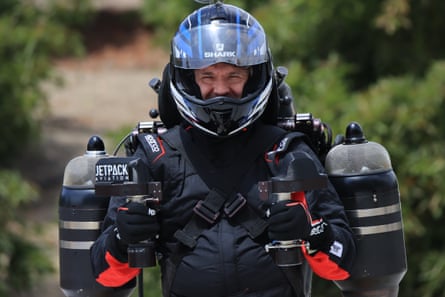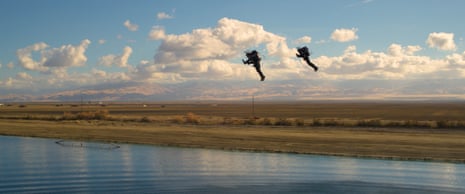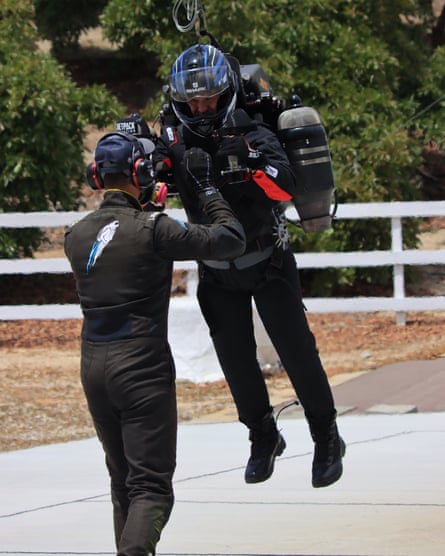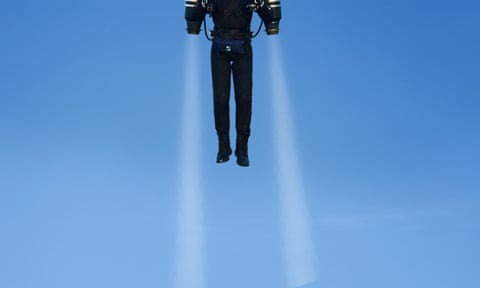We have jetpacks and we do not care. An Australian named David Mayman has invented a functioning jetpack and has flown it all over the world – once in the shadow of the Statue of Liberty – yet few people know his name. His jetpacks can be bought but no one is clamouring for one. For decades, humans have said they want jetpacks, and for thousands of years we have said we want to fly, but do we really? Look up. The sky is empty.
Airlines are dealing with pilot shortages, and this promises to get far worse. A recent study found that, by 2025, we can expect a worldwide shortfall of 34,000 commercial pilots. With smaller aircraft, the trends are similar. Hang-gliding has all but disappeared. Ultralight aircraft makers are barely staying afloat. (One manufacturer, Air Création, sold only one vehicle in the US last year.) With every successive year, we have more passengers and fewer pilots. Meanwhile, one of the most dreamed of forms of flight – jetpacks – exists, but Mayman can’t get anyone’s attention.
“I did a flight around Sydney harbour a few years ago,” he tells me. “I still remember flying around close enough to see the joggers and the people walking around the botanical area, and some of them did not look up. The jetpack is loud, so I promise you they heard me. But there I was, flying by on a jetpack, and they did not look up.”

When I turned 40, I began experimenting with any kind of flying I could – helicopters, ultralights, gliders, hang-gliders. It was less a mid-life crisis thing and more that I finally had, or made, time to do the things I’d long wanted to do. So I tried paragliding, skydiving. One day I stopped by a roadside airstrip in California’s wine country that offered flights in first world war biplanes. They didn’t have any biplanes available that day, but there was a second world war bomber, a B-17G called Sentimental Journey, gassed up, so I went up in that. Inside, the plane looked like an old aluminum boat; it was crude and lumpy, but it flew steady and hummed like a Cadillac. We flew over green and auburn hills for 20 minutes, the sky white as a frozen lake, and it felt like a good use of a Sunday.
Because I have no idea what I’m doing, and I am not good at math or reading wind patterns or checking dials or gauges, I’ve done all these things as a passenger, not a pilot. I will never be a pilot. I know this. Pilots should be organized and methodical, and I am not these things.
But being around these pilots has given me a deep appreciation for those who continue to push ahead – to experiment and exult in flight. My respect for pilots is infinite, and for the past 10 years, my primary teacher has been a French-Canadian named Michael Globensky, who teaches ultralight trike flying in Petaluma, California. He used to teach hang-gliding, but that business was dead, he said. Fifteen years ago, the students disappeared. For a while, he still had ultralight clients, though – those who wanted to fly as passengers, and some students, too. But the work has declined precipitously. Last time I saw him, he had no students at all.
Still, every so often, we go up. The ultralight trike we fly is a bit like a two-seat motorcycle with an oversized hang-gliding wing attached above. The ultralight is unprotected from the elements – there is no cockpit; pilot and passenger are exposed – so we wear sheepskin coats, helmets and heavy gloves. Globensky rolls to the runway, waiting for small Cessnas and turboprops to pass by, and then we take our turn. The ultralight accelerates quickly, powered by a propeller in the rear, and after 90 meters Globensky pushes the wing gently outward and we’re aloft. The takeoff is almost vertical, much like a kite pulled upwards by a sudden gust.
Once we’re away from the airstrip, the feeling is otherworldly, entirely different from sitting in any other aircraft. All around is wind and sun, and nothing stands between us and clouds and birds as we fly over the highway, over the farms of Petaluma and toward the Pacific. Globensky likes to hug the coast above Point Reyes, the surf below like spilled sugar. Our helmets have microphones and, once every 10 minutes, one of us says something, but usually it’s just us in the sky, silent but for the occasional John Denver song. That song is almost always Rocky Mountain High. Sometimes I’m tempted to ask Globensky if we could do without John Denver’s Rocky Mountain High – especially given this particular singer-songwriter died piloting an experimental plane, just south of us, in Monterey – but I don’t have the heart. He really loves that song.
I am thinking about Globensky while waiting in the parking lot of Ralphs supermarket in Moorpark, a dry agricultural town in southern California. This parking lot is where Mayman and Boris Jarry, the proprietors of Jetpack Aviation, have told us to meet. I have signed up for a weekend jetpack training session, in which I’ll get to wear and operate their jetpack (the JB10) with what I assume will be a few dozen other students.
But as I wait in the parking lot, I meet only four other people – two pairs – who are there for the training session. First there is William Wesson and Bobby Yancey, sturdily built men in their 40s who have come 2,000 miles from Oxford, Alabama. They pull up next to me in a rented sedan. “Jetpack?” they ask. I nod and they park and we wait. Wesson is a pilot who’s flown just about everything – airplanes, gyroplanes, helicopter. Now he works for the local power company, flying helicopters around the region, checking for downed lines. Yancey is his best friend, along for the ride.
The other pair are Jesse and Michelle. Wry and wearing red-rimmed glasses, Michelle is there to support Jesse, a Colin Farrell lookalike who has worked with Mayman and Jarry for years as an aerial videographer. He’s the one who shot the footage of Mayman flying around the Statue of Liberty and Sydney harbour. Given to saying “Copy that” instead of “Yes”, Jesse is, like me, flight-curious, flight-adjacent – always the passenger, never the pilot. He’s always wanted to fly the jetpack but has never had the chance.

Finally, a black pickup truck thunders into the lot and a tall, athletic Frenchman leaps out. This is Jarry. He is bright-eyed and bearded, and is never less than ecstatic about his work. I had assumed he wanted to meet at the supermarket because the jetpack training facility was hard to find or – even better – its location was top secret. But no. Jarry tells us to go into Ralphs, get whatever we want for lunch, put it in his cart, and he’ll pay for it and bring it along to the training facility. And thus our first impression of the Jetpack Aviation training programme is a tall Frenchman rushing through the supermarket, pushing a shopping cart.
After he packs our food into the truck, we get into our cars and follow him, caravanning through Moorpark’s flat fields of fruits and vegetables, the white spray of sprinklers cutting through the rows of green and aquamarine. We pass pickers in wide straw hats gathering strawberries and melons, and then we rise on dusty roads through hills of lemon and fig trees, past eucalyptus windbreaks and finally into a dense farm of avocado trees, where, about 800ft above sea level, the Jetpack Aviation compound is located.
It is a humble setup. A two-acre clearing has been made, set off from the rest of the farm by a white wooden fence. Inside the roughly circular clearing, there are stacks of firewood and sheet metal, an old tractor and a few aluminum outbuildings. Jarry tells us that the farmer who owns the land is a former pilot himself, and lives in the house at the top of the ridge. “He doesn’t mind the noise,” Jarry says, squinting up to the Spanish colonial high above.
In the centre of the compound is the jetpack test platform, a concrete rectangle about the size of a basketball court. We students wander around for a few minutes before finding the jetpack, hung like a museum piece inside a shipping container. The jetpack is a beautiful and simple object. It has two specially modified turbojet engines, a large fuel container and two handholds – the right contains the throttle and the left the yaw. There are computerized elements to the jetpack, sure, but for the most part it’s a simple to understand machine. It looks precisely like a jetpack should look, and no space or weight is wasted. It has two turbojets with a combined maximum thrust of 375lb. Its fuel capacity is 9.5 gallons. Dry, the jetpack weighs 83lb.
The machine, and the entire compound, really, is utterly unglamorous, and reminds me, immediately, of Nasa – another deeply unglamorous place built, and maintained, by serious people who don’t care, at all, about appearances. The Nasa facilities in Cape Canaveral, nestled amid Florida swamps and scrubland, are functional and without fuss. The budget for landscaping appeared to be zero. When I watched the last flight of the space shuttle, I was startled at every turn by the lack of attention paid to anything unrelated to the task at hand – to build new things that fly.
In Moorpark, we sit in a small makeshift hangar, where a large TV plays footage of Jarry and Mayman flying various incarnations of their jetpack. The video cycles through their flights in southern California, in New York, at the start of a Formula One event in Monaco. Every so often, a short clip from Thunderball, the James Bond movie that first featured a rocket belt, is stitched in for comic relief. Jarry tells us that Mayman is busy on a call with investors, so he’ll be handling the basic instruction. In a thick French accent, he races through matters of throttle and yaw, safety and calamity, and after 15 minutes on the whiteboard, apparently we’re ready to put on our gear. I am not at all ready, but this doesn’t matter. I’ve decided I won’t be going first.
The first garment is a kind of flame-retardant long underwear. Then a pair of heavy wool socks. Then a pair of silver pants, lightweight but flame-resistant. Then another pair of heavy wool socks. Then a jumpsuit. A helmet. Flame-resistant gloves. And, finally, a pair of heavy leather boots that will prove crucial to keeping us from scorching our feet. (More about that soon.)
Because Wesson is a trained pilot, we decide that he’ll go first. He climbs the three steel-grated steps and slips into the jetpack, which is hanging from a pulley in the center of the tarmac. While Jarry straps him in, Mayman appears. He’s a trim man of 50, bald and blue-eyed, long-limbed and soft-spoken. He welcomes us all with handshakes and greetings, and then goes to retrieve a jerrycan of kerosene from one of the shipping containers.
When he returns and begins pouring the fuel into the jetpack, only then does it register just how dicey this seems, and why jetpacks have been slow to be developed and adopted. Though every day we fill our cars’ tanks with highly flammable gasoline, there is – or we pretend there is – a comfortable distance between our frail flesh and this explosive fuel. But carrying this fuel on your back, in a glorified backpack of tubes and turbines, brings the reality of the internal combustion engine home. Just watching the kerosene getting poured into the pack, inches from Wesson’s face, is unsettling. But still, it’s the best technology we have, and it took Mayman 15 years, and dozens of unsuccessful iterations, to get here.

Not that he was the first. The first person on record to patent the idea of a jetpack – or rocket pack, in this case – was Alexander Andreev, a Russian engineer who imagined soldiers using the device to leap over walls and trenches. He never built his rocket pack, but the Nazis borrowed the notion for their Himmelsstürmer (heaven stormer) programme – which they hoped would give Nazis superhuman powers of bounding. The war ended, thank God, before this came to be, but the idea persisted in the minds of engineers and inventors. It wasn’t until 1961, though, that Bell Aerosystems developed the Bell Rocket Belt, a simple two-jet pack that could propel the wearer upwards for 21 seconds, using hydrogen peroxide as fuel. A variation of this technology was used in the 1984 Olympics in Los Angeles, when a pilot, Bill Suitor, flew over the opening ceremony.
Hundreds of millions of people watched that demonstration, and the human race could not be blamed for assuming an everyday jetpack was around the corner. Mayman was a teenager when he watched Suitor hover over the LA Coliseum, and the image never left him. He grew up in Sydney, Australia, and learned to fly before he learned to drive; he had his pilot’s license when he was 16. He went to college and became a serial entrepreneur, finally creating and selling a Yelp-like company and, with the windfall, moved to California to pursue his dream of creating his own jetpack. Starting in 2005, he worked with engineers out of an industrial park in Van Nuys, building and testing crude variations of the technology. And though he got training from Bill Suitor – the same man who inspired him at the 84 Olympics – all along, there was only one test pilot for all of these jetpack variations. That was David Mayman himself.
With early incarnations of the pack using 12 engines, then four, he routinely bumped into the buildings (and cacti) around that Van Nuys industrial park. In a bad week of test flights in Australia, he crashed on a Sydney farm one day and was hospitalized with severe burns to his thighs. Because he had planned to fly over Sydney harbour the next day, he discharged himself from the hospital and flew, briefly, over the harbour before crashing again, this time in the drink. More R&D ensued, and, finally, Mayman settled on the two-jet design featured in the JB9 and JB10. With this version – the version we are testing today – there have been no significant accidents.
It’s important to note, though, that Mayman and Jarry fly their jetpacks almost exclusively over water – they have not yet devised a way to wear both the jetpack and a parachute.
Which is why we are flying this day on a tether. And why we fly no more than 4ft off the ground. Is it enough? I’m sitting on the edge of the tarmac, watching Wesson get ready, and I’m wondering if this experience – flying 4ft over concrete – will offer anything like real flight. Though I’ve loved every flight I’ve taken in all the craft I’ve experimented with, I always come back to one experience as being the closest to pure flight, to really feeling weightless. It was on a golden hill, the grass like mohair, on California’s central coast, where a man in his mid-60s was teaching me to fly a hang-glider. First we assembled the contraption, everything about it primitive and ungainly – a mess of poles and bolts and strings – and, finally, I was standing at the top of the hill, ready to run down and jump. And that was the essence of it – to run and, at the moment when the sail above me caught the gentlest wind, to jump and float the rest of the way. I did this a dozen times that day, late into the afternoon, never flying more than 100ft. I find myself, daily, thinking about that weightlessness, the silence and simplicity of hanging under a sailcloth wing, the rush of the mohair hill under my feet.
But I digress. I’m now sitting in a plastic chair, next to the tarmac, watching Wesson. He’s standing on the steel-grated steps, wearing a helmet so tight that his cheeks have become part of his nose, his eyes crowded into the deep recesses of his face. At Jarry’s signal, Wesson activates the jets, and they howl like an incoming mortar. The smell is burning jet fuel and the heat is three-dimensional. Yancey and I are sitting at the outer fence of the compound, in the waning shade of the eucalyptus trees, and it’s exactly like standing behind an airplane as it powers up on an airstrip. Which no one should do.

Meanwhile, Jarry stands in front of Wesson, guiding him with gestures and head movements as he steers up and down, left and right. Though Wesson controls the jets with the throttle and yaw, his eyes never leave Jarry’s – he’s locked in like a battered boxer getting a standing 10-count. He moves carefully around the tarmac, never more than 4ft aloft, and then, far too soon, it’s over. And this is the tragedy of jetpack technology. They can’t hold enough fuel for more than eight minutes of flight – and even that’s the upper end. Kerosene is heavy, burns quickly, and a human can only carry so much. A battery would be far better, but they’re much heavier – at least for now. Someday someone might invent a battery light and energy-efficient enough to do better than kerosene, but, for now, you can only use what you can carry, and that’s not much.
After he ducks out of the jetpack, Wesson collapses on the plastic chair next to Yancey, his face bright pink and limbs limp. He’s flown just about every kind of airplane and helicopter, but “that”, he says, “is the hardest thing I’ve ever done”.
Which is why I let Jesse go next.
Jesse does fine, flying up and down with good command, but then he does something I didn’t know we weren’t supposed to do: he lands on the tarmac. Landing on the tarmac is something planes routinely do – in fact, it’s where they usually land – but with a jetpack, something unfortunate happens when the pilot lands on concrete. The jet turbines on the pilot’s back blow 800-degree exhaust on to the ground, and this heat has nowhere to go but out, spreading across the pavement like a bomb radius. When Jesse was standing, or landing, on the steps, the exhaust could pass down through the grated steps and be dispersed below. But standing on the concrete, with the exhaust spreading instantly in the direction of his boots, it attacks his feet, his calves. Jarry and Mayman leap into action. With his remote control, Mayman turns off the turbines, while Jarry brings a tub of water over. In one practiced motion, he guides Jesse’s feet, boots and all, into it. Steam does not shoot from the tub, but still, lesson learned. Don’t land on the tarmac with the engines running.
When it’s my turn, I step up the steel-grated steps and slip, sideways, into the jetpack as it hangs from the pulley. While it’s suspended from the pulley, I can feel its weight, but when Jarry lowers it on to my back, the burden is significant. The pack is engineered such that the weight is well distributed and manageable, but 90lb – the dry weight plus the fuel – is no joke. It must be said that Mayman’s engineers have done a remarkable job with the balance and the intuitiveness of the controls. Instantly, it feels correct, all of it.
That is, until the buckles and straps. There are many buckles and straps, and they fit precisely like a skydiving kit, with an emphasis on groin-cinching. Before I can say anything about the groin-cinching, Jarry is explaining the throttle, which is in my right hand and gives the jet turbines more or less fuel. The control in my left hand is the yaw, directing the jet exhaust left or right. There are a few lights and gauges installed in the hand-holds but, for today, I’ll be getting all of my information from Jarry. Like Wesson and Jesse before me, my cheeks are being pushed into my nose, and I’m in an eye-lock with Jarry, waiting for any micro-instruction that will help me not die.

Mayman fills the pack with kerosene, and steps back to the side of the tarmac, remote control in hand. Jarry asks if I’m ready. I tell him I’m ready. The jets ignite. The sound is like a category 5 hurricane passing through a drainpipe. Jarry turns an invisible throttle, and I mimic his movements with the real throttle. The sound grows louder. He turns his invisible throttle more, and I turn mine. Now the sound hits a fever pitch, and I feel the thrust down the back of my calves. I step ever so slightly forward, and lock my legs together. (This is why jetpack wearers have their legs stiff like toy soldiers – any deviation is quickly punished by 800-degree jet exhaust.) Jarry mimes more throttle, I give it more throttle, and slowly I leave the earth. It is nothing like weightlessness. Instead, I feel my every pound, feel just how much thrust it takes to get me and this machine to levitate.
Jarry tells me to go higher. One foot, then two, then three. As the jets howl and the kerosene burns, I hover, thinking that this is an astounding amount of noise and trouble to float 36in off the ground. Unlike the purest kinds of flight, which harness wind and master soaring, this is just brute force. This is busting through space with heat and noise. And it’s really difficult, too. Especially when Jarry asks me to go left and right.
Turning left and right requires manipulating the yaw – the grip in my left hand, which moves the direction of the jet exhaust. On its own this would be easy enough. But I have to do this while maintaining consistent throttle so I don’t land on the tarmac as Jesse did. Keeping the throttle steady while adjusting the yaw, all while keeping my legs stiff and staring into Jarry’s ecstatic eyes, is not easy. It requires an all-mind, all-body level of concentration that I’d compare to big-wave surfing. (I have never done big-wave surfing.)
And then there is going forward and back. This is an entirely different, and far more challenging, task. To go forward, the pilot has to move the entire apparatus. Picture a triceps machine at the gym. I have to tilt the jetpack – everything on my back – away from my body. Doing the opposite, pulling up on the grips so my hands approach my shoulders, turns the jets toward my ankles, sending me backwards. Because I know nothing about anything, I won’t comment on the wisdom of this engineering; I will only say I don’t like it, and wish this were more like the throttle and yaw – more automated, more responsive, and less likely to burn (think blowtorch on butter) the skin off my calves and ankles.
After each of my test flights, I get down from the steps, take off my helmet and sit with Wesson and Yancey, rattled and exhausted. If it’s the hardest kind of flying Wesson’s ever done, by extension I figure I’m ready to fly a helicopter. While we watch Jesse get marginally better, and as the sun drops below the tree line, we talk about what we could do to improve, and the practicality of this machine in general. At the moment, the flight duration is too short, and the degree of difficulty too great. But this was also the case – and then some – for the Wright brothers. Their first motorized flyer was exceedingly difficult to fly for anyone but themselves, and it was a good decade between their demonstrations and the first practical, mass-market airplanes that could be flown by anyone else. Meanwhile, no one was much interested. In the first few years of their test flights, they flew in plain sight, between two highways in Dayton, Ohio, to the resounding indifference of the world.
Which is where Mayman and Jarry still find themselves. They have done the difficult work, which is to design, manufacture and test a jetpack simple and intuitive enough that a rube like me can fly under controlled conditions. With enough investment, they could bring the cost down significantly, and they very well might be able to solve the flight-duration issue, too. But, for now, there are two paying customers at the Jetpack Aviation bootcamp, with the rest of the human race giving this pair of visionaries a collective shrug.
A month after my training, I’m sitting at home, trying to think of an ending for this story, when I read a news item about a jetpack being spotted flying at 5,000ft near Los Angeles international airport. “The jet man is back,” the air traffic controller at LAX said, for this was not the first sighting. It turns out that between August 2020 and August 2021, at least five jetpack sightings were recorded – most of them in southern California, at altitudes between 3,000 and 6,000ft.
I email Mayman, asking what he knows about the phenomenon, hoping this mystery jetpack man was him. Because I take him to be an extremely responsible person, it seems out of character for him to be flying so high, and in restricted airspace, but, then again, there is no record of anyone else in California owning, much less being capable of flying, a jetpack.
A week goes by and I don’t hear back from Mayman. In his silence, wild theories bloom. Of course it’s him, I think. Only he is capable of such a flight, and only he has a motive. After trying to attract the world’s attention through straightforward means – YouTube videos and advertisements in the Wall Street Journal, for instance – he’s been forced to go rogue. Pilots and air traffic controllers at LAX begin referring to the pilot as Iron Man – and the person behind the stunts is acting like the superhero’s alter ego Tony Stark, waiting until the right moment to reveal it was him all along.
Finally, almost two weeks after sending my email, I hear back.
“I wish I did know something about what’s going on around LAX,” Mayman writes. “There is no doubt the airline pilots saw something but I doubt very much it was a jet-turbine-powered jetpack. They just don’t have the endurance to get up to 3,000 or 5,000ft, fly around for a while and then come down and land. Personally, I think it is probably an electric drone with an inflatable mannequin set up to look like a person wearing a jetpack.”
And so dies another delicious enigma. There may not be renegade jet-people flying in restricted airspace, and we might not get our own jetpacks in our lifetimes, but we can content ourselves with two very careful jet-persons, Mayman and Jarry, occasionally flying around an avocado farm, if only to prove they can.
